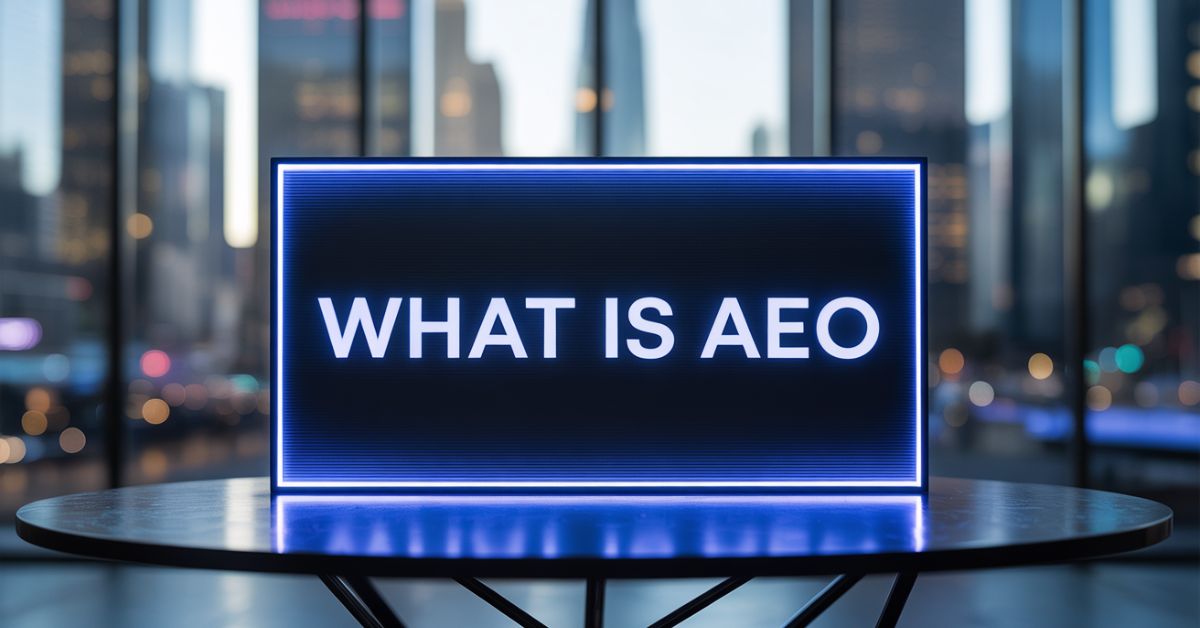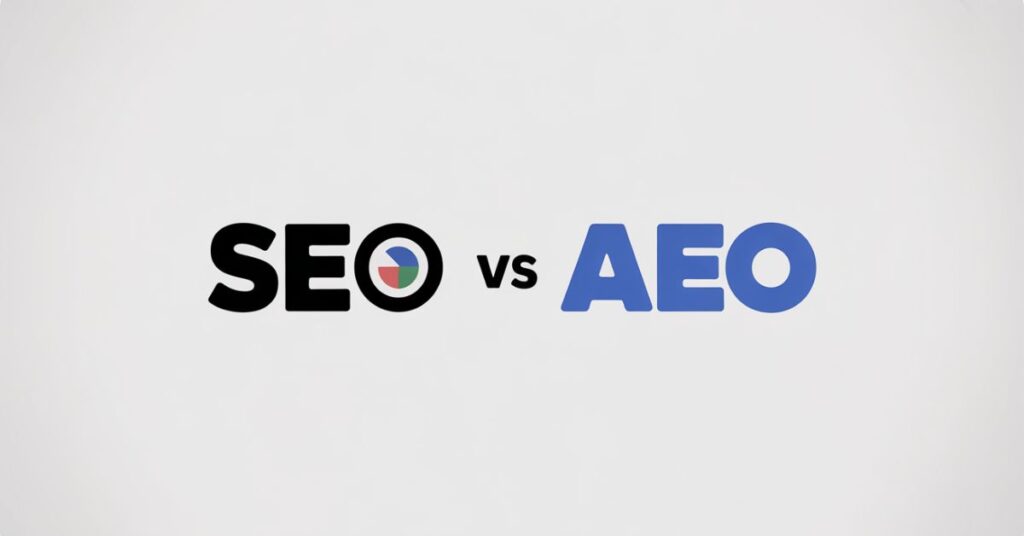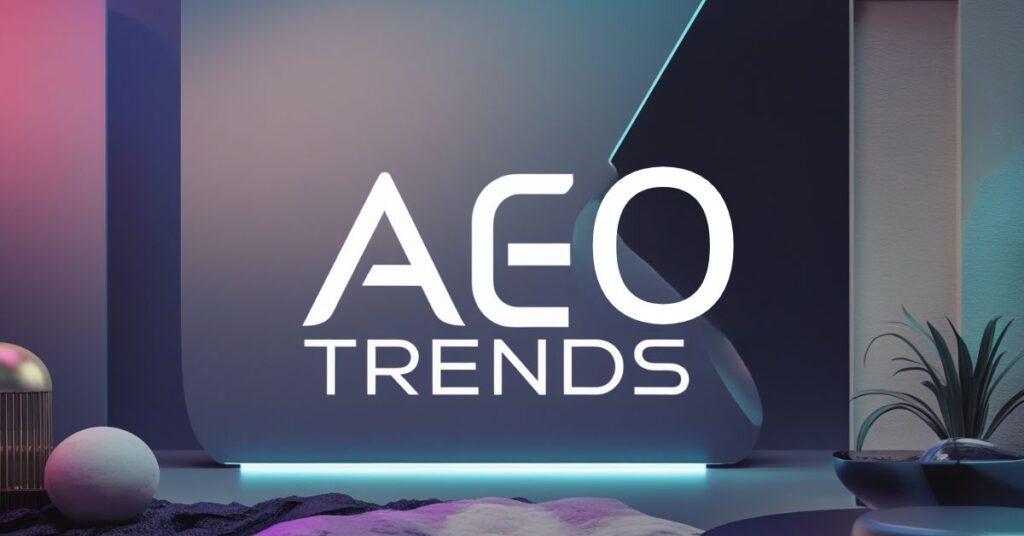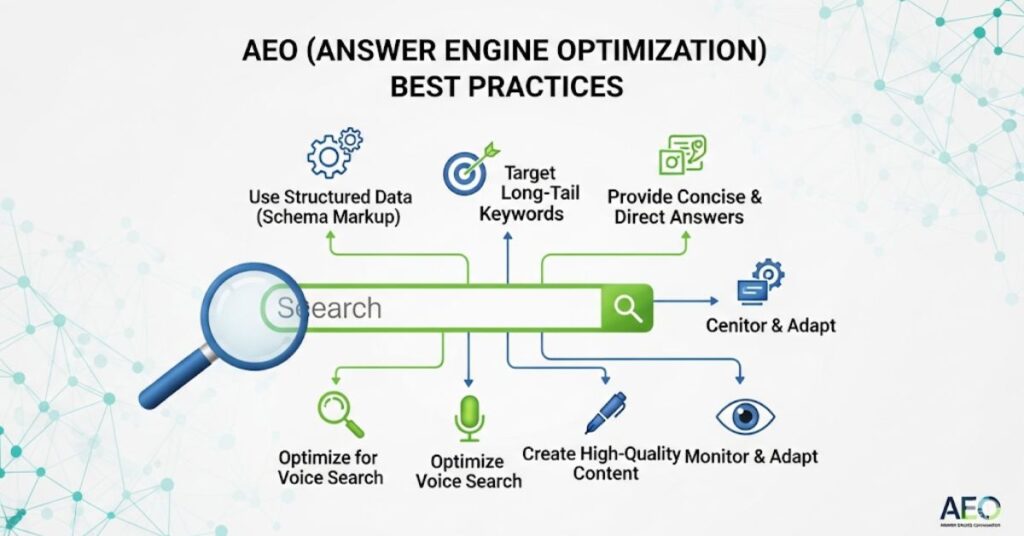Answer Engine Optimization (AEO) is the process of tailoring your content so it appears as the direct response in AI-powered platforms such as ChatGPT, Google SGE (Search Generative Experience), Perplexity AI, and Microsoft Copilot. Unlike traditional SEO that focuses on ranking in search engine results pages (SERPs), AEO is about being chosen as the best answer to a user’s question.
The goal of AEO is simple: when someone asks a question, your content becomes the answer. Whether it’s voice search, smart assistants, or AI summaries, AEO puts your brand front and center.
AEO vs SEO: What’s the Real Difference?
While SEO and AEO share some similar tactics, their goals and approaches differ. Here’s a quick comparison:
| Feature | SEO | AEO |
| Platform | Google, Bing, DuckDuckGo | ChatGPT, Perplexity, Copilot, Gemini |
| Focus | Keywords & rankings | Conversational questions & direct answers |
| Metrics | Rankings, traffic, impressions, conversions | Mentions, citations, placements |
| Format | Blogs, pages, structured content | Direct answers, schema-rich snippets |
In simple terms, SEO helps you get found in search engines. AEO helps you get chosen as the best answer in AI tools.
Why AEO Matters More Than Ever in 2025
The search landscape is changing rapidly:
- 57% of Google searches in 2024 ended with zero clicks. (SparkToro)
- 80% of Gen Z prefers asking AI tools or voice assistants over typing in search bars. (Edison Research)
- Platforms like ChatGPT and Perplexity are becoming go-to sources for quick, trusted answers.
Without AEO, your brand might be left behind in AI-driven searches. Users aren’t clicking links like they used to. If your content isn’t directly answering their questions, you won’t even be part of the conversation.
How Answer Engines Like ChatGPT and Perplexity Work
Unlike traditional search engines that index and rank content, answer engines work by predicting the most appropriate next word or phrase using their training data.
They rely on massive datasets, which include public web data, licensed content, and brand-specific details. For example, if your site shares expert advice on taxes, ChatGPT may cite it when a user asks about “how capital gais tax works.”
These engines don’t “search” the web live. Instead, they reference patterns and sources learned during training. That’s why creating unique, well-structured, and widely-cited content increases your chances of being included.
AEO vs GEO: Don’t Confuse the Two
Another newer term marketers are hearing is Generative Engine Optimization (GEO). While similar, there are clear distinctions:
| Aspect | AEO | GEO |
| Aim | Be the answer | Be part of the generated summary |
| Strategy | Schema, format, clarity | Authority, topical depth |
| Best for | Short, specific questions | Broad, complex topics |
AEO = Direct answer. GEO = Partial contribution. Both are valuable, but they serve different functions in the AI world.
How to Optimize for AEO (Step-by-Step Guide)
- Start with Common Questions
Use tools like Google’s “People Also Ask”, AnswerThePublic, and AlsoAsked to find real user queries. Prioritize informational and transactional questions. - Lead with the Answer
Start each piece of content with a clear 1-3 sentence answer. Then explain in detail. - Use Schema Markup
Implement structured data like FAQPage, HowTo, and Article schema. This helps AI tools interpret your content. - Format for Skimmers
Use H2s for questions, bullet points, short paragraphs, bold keywords, and add visuals when relevant. - Add Internal Links
Help engines and users explore deeper by linking to related content on your site.
On-Site vs Off-Site AEO Strategies
On-Site Strategies
- Write content with direct, clear answers.
- Use schema markup properly.
- Optimize headings and use visuals.
- Add internal linking and short paragraphs.
Off-Site Strategies
- Gain backlinks from high-authority websites.
- Claim and optimize local listings.
- Encourage reviews on sites like Yelp, G2, and Google.
- Maintain active and optimized social media profiles.
Both on-site and off-site actions work together to boost your authority and visibility in AI-generated results.
The Challenges of AEO — And How to Overcome Them
1. Tracking Is Limited
One of the biggest challenges in Answer Engine Optimization (AEO) is the lack of reliable tracking tools. Unlike traditional SEO, where platforms like Google Search Console, Ahrefs, or Semrush provide clear metrics on rankings, impressions, and traffic, AEO still lacks an industry-standard reporting solution. This is because answer engines like ChatGPT, Perplexity AI, Gemini, and Claude don’t publicly disclose citation metrics, user interaction data, or traffic referrals in a way that can be easily measured.
That’s why many marketers turn to tools like OmniSEO, one of the few platforms currently offering mention and citation tracking across multiple AI engines. OmniSEO helps identify when your brand is cited in conversational results and which queries trigger your mentions. However, it’s a paid tool and may not be accessible for every business.
As an alternative, manual tracking is still a valid option. This involves entering common conversational queries into different AI platforms and logging whether your brand, website, or content is mentioned or cited in the answer. Although this method is time-consuming, it provides direct insight into how well your AEO efforts are working, especially when monitored consistently over time.
2. Gaining Internal Buy-In
Another hurdle in implementing AEO is convincing internal stakeholders, such as executives, marketing directors, or decision-makers, of its value. Since AEO is still a relatively new concept, many business leaders are unaware of how search behavior is shifting toward AI-driven platforms.
To gain support, it’s essential to explain how AI search is growing rapidly and reshaping the digital landscape. Share relevant data: For instance, more than 400 million people use OpenAI’s tools weekly, and Gartner predicts that by 2026, 25% of all organic traffic will be redirected to AI-powered platforms rather than traditional search engines.
Also, point to real-world examples. Platforms like Stack Overflow have seen traffic drops since the rise of ChatGPT, while companies like NerdWallet have maintained strong revenue growth despite decreasing organic visits. These examples illustrate that consumers aren’t abandoning research, they’re just doing it in new places.
Finally, explain that AEO isn’t meant to replace SEO. Instead, it complements existing efforts by expanding your brand’s reach into AI platforms, ensuring your content is visible wherever people search for answers. This forward-looking strategy positions the company for long-term growth, even as user behavior continues to evolve.
3. AI Engines Differ
When optimizing for AEO, it’s critical to understand that not all AI engines behave the same way. Platforms like ChatGPT (OpenAI), Gemini (Google), Claude (Anthropic), Perplexity AI, and Microsoft Copilot all operate on different datasets, user interfaces, and ranking logics. A one-size-fits-all content strategy will likely fall short.
For example, ChatGPT tends to prioritize concise and factual information, often pulling from authoritative sites with clear formatting. Gemini may lean toward Google-indexed content, especially sources that follow E-E-A-T (Experience, Expertise, Authoritativeness, and Trustworthiness) guidelines. Meanwhile, Perplexity values detailed explanations with strong source references, and Claude may favor context-rich answers written in a natural tone.
This variation means you must test and tailor your content for each engine. Start by entering your target questions into each platform and analyzing the responses. Identify what types of answers rank best: Are they brief? Do they include bullet points? Do they link to external sources? Then, model your content accordingly.
AEO Success Stories: Real-World Examples That Work
- A SaaS platform appeared in Copilot and DuckDuckGo by creating in-depth help articles.
- A tax advisory firm ranked in AI Overviews by answering tax questions clearly using schema.
- A healthcare blog gained mentions in Perplexity by structuring content into bullet-based FAQs.
These brands invested in clarity and consistency, not just keywords.
Is AEO the Future of Search? Here’s What Experts Predict
Experts predict:
- 25% of organic traffic will shift to AI chatbots by 2026. (Gartner)
- ChatGPT may soon offer sponsored answers, opening new advertising routes.
- Brands ignoring AEO will lose discoverability as users skip traditional search.
The shift has already begun. And first movers have the upper hand.
Conclusion
In 2025 and beyond, AEO is the gateway to visibility in the AI-powered web. As zero-click searches rise, your content must stand out not just in Google, but also in conversational, intelligent platforms like ChatGPT, Copilot, and Perplexity.
By investing in AEO now, writing smarter content, formatting with structure, and building off-site authority, you’re not just keeping up with the times. You’re shaping the future of how people discover your brand.



